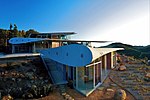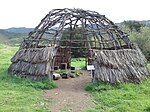Point Mugu State Park

Point Mugu State Park is a state park located in the Santa Monica Mountains National Recreation Area in Southern California. The rugged, nearly impassible shoreline of the western Santa Monica Mountains gives way to tidal lagoons and coastal sand dunes at Mugu Rock. The western edge of the park adjoins Mugu Lagoon which is a protected area within Naval Air Station Point Mugu. Point Mugu SP consists of distinct landside and beachside areas with different ecosystems and their own parking lots, separated by the Pacific Coast Highway. During low tide, the parks are joined by a walkway under an adjoining bridge. The park may be accessed from the eastern part of the Santa Monica Mountains from a National Park Service park, Rancho Sierra Vista in Newbury Park, California that includes the Satwiwa Native American Indian Culture Center, and from the western part of the Santa Monica Mountains by the Pacific Coast Highway.
Excerpt from the Wikipedia article Point Mugu State Park (License: CC BY-SA 3.0, Authors, Images).Point Mugu State Park
Serrano Valley Trail,
Geographical coordinates (GPS) Address Nearby Places Show on map
Geographical coordinates (GPS)
| Latitude | Longitude |
|---|---|
| N 34.1 ° | E -119 ° |
Address
Serrano Valley Trail
Serrano Valley Trail
California, United States
Open on Google Maps









